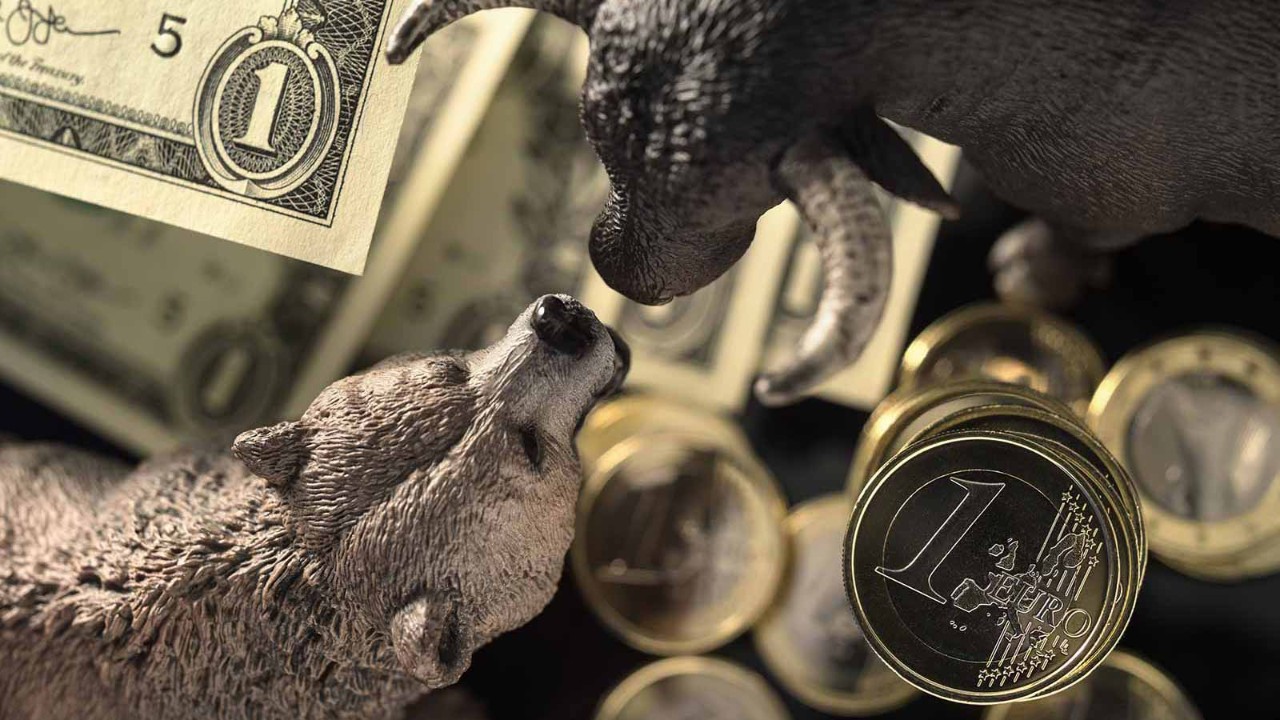
A weak currency can be a knock to a nation’s self-esteem. But it also potentially provides a boost to companies, making exports more competitive and lifting the domestic value of profits earned abroad.
As a result, many chief financial officers in the eurozone may be looking with some anxiety at the latest trend in the foreign exchange markets.
‘The euro is bouncing off extremely weak levels, so the currency is still far from being at uncompetitive levels for eurozone businesses’
The euro is recovering from a period of exceptional weakness. Having fallen to its lowest level ever against the US currency in September 2022, the single currency is up almost 10% against the dollar.
Since the US is Europe’s largest trading partner, accounting for 15% of eurozone exports in 2021, such an appreciation should present a headwind for internationally focused companies. Even on a broader trade-weighted basis – evaluating the euro against the currencies of its major trading partners – the single currency is up more than 4% since its September low.
Worry factor?
So how far could the euro’s rally go and how worried should the region’s exporters be?
Predicting the future of currencies is challenging – and with so many variables at play, it’s often compared to attempting to forecast the shape of clouds. That said, the euro does have the wind at its back at present.
Over the course of 2022, the European Central Bank (ECB) transformed from being one of the world’s most cautious top central banks in raising rates to one of the most aggressive. In December ECB president Christine Lagarde followed the announcement of a rate hike of 50 basis points with the unexpectedly hawkish warning that rates ‘would still have to rise significantly and at a steady pace’.
She added that 50-basis point hikes were possible at each of the next three meetings. That would be roughly twice the level of rate rises that most economists are expecting from the US Federal Reserve. All else being equal, this sudden turn of aggressive rate increases should support further euro appreciation.
More vulnerable
It is also worth noting that eurozone companies are more vulnerable to currency appreciation overall than counterparts in the US. That’s because eurozone exports of goods to non-eurozone countries are equivalent to 20% of eurozone GDP, whereas the equivalent number for the US is only 10%, based on the latest full data from 2020.
Stock market earnings are even more impacted by movements in foreign exchange markets, with about 50% of revenues from companies in the MSCI EMU index coming from outside the zone.
‘The strength of the global economy will remain the key variable for eurozone exporters’
For example, German automaker BMW has its largest factory worldwide not in Germany, but in South Carolina, a plant in which it has invested nearly £12bn since 1992 and which now produces 1,500 vehicles a day. The facility even exports vehicles back to Germany, as well as to China, South Korea, Canada and the UK.
Since profits from these operations are translated into euros when BMW releases its financial results, a surge in the single currency would represent a headwind.
Cause for optimism
But there are reasons that the recent rise of the euro should not be too alarming for eurozone businesses, says Andrew Kenningham, chief Europe economist at Capital Economics. The first is by putting the latest euro rise in context. ‘The euro is bouncing off extremely weak levels, so the currency is still far from being at uncompetitive levels for eurozone businesses,’ he says.
Between the start of 2021 and September 2022, the euro fell more than 20% against the dollar and close to 8% on a trade weighted basis (using the Bank of England’s measure).
‘The really big swings in eurozone exports have been due to shifts in the global economy’
‘Really what we are seeing is the unwinding of a period of extraordinary dollar strength, rather than a surge in the euro,’ says Kenningham. ‘We might need to see the euro rising above 1.20 against the US dollar, up from current levels around 1.06, before the ECB would start to worry about a loss of competitiveness.’
In addition, while the eurozone is more vulnerable to currency moves than the US, the region is less impacted than smaller economies – such as Switzerland, Singapore and the UK. In 2021, for example, exports of goods and services accounted for 28% of UK GDP.
An appreciating currency also has its benefits for companies, reducing the price of imported supplies and components. ‘In a period of high inflation, a stable or rising euro can be helpful, and, on the margin, could moderate the pace at which the ECB raises rates – and hence borrowing costs for companies,’ says Kenningham.
Most importantly, however, currency effects have recently been swamped by other forces – including global demand and energy prices. Looking forward in 2023, these should loom far larger than the euro in the list of worries for eurozone executives.
‘The strength of the global economy will remain the key variable for eurozone exporters,’ says Kenningham. ‘The really big swings in eurozone exports – including the 21% fall during the pandemic and the 16% decline following the 2008 financial crisis – have been due to shifts in the global economy.’
Partner performance
As a result, the main questions for executives in the coming year will be the economic fortunes of the eurozone’s main trading partners – with the US, UK, China, Poland and Switzerland making up the top five. So the key to eurozone export performance in 2023 will be whether the US avoids a recession, how deep the downturn is in the UK, and how swiftly China recovers from the latest wave of Covid-19 infections.
In addition, executives in energy-intensive sectors – including chemicals, metallurgy, paper pulp and glass – will be asking whether the recent decline in natural gas prices will last. The TTF European gas benchmark – which surged as much as 350% in 2022 to €311 – has since fallen back below €70. That has thrown a lifeline to a range of eurozone businesses.
The bottom line is that a higher euro looks set to add a modest headwind for the eurozone in 2023. But the currency’s recent appreciation partly reflects the relative resilience of the Eurozone economy, due in part to the recent helpful decline in natural gas prices. The bigger worry for companies – and the major reason Capital Economics expects the region’s exports to be flat in 2023 – is lacklustre global growth.



